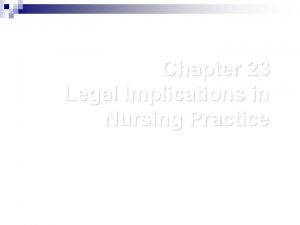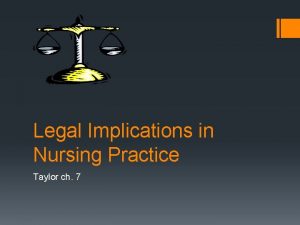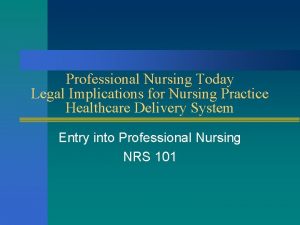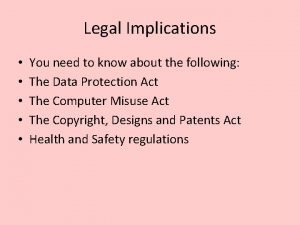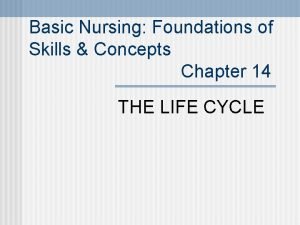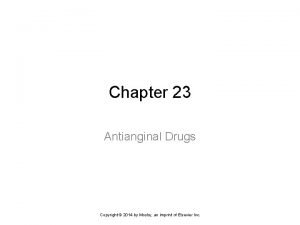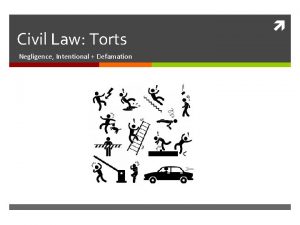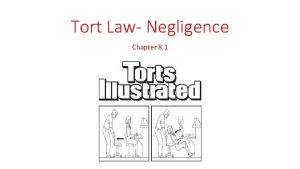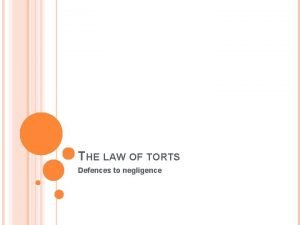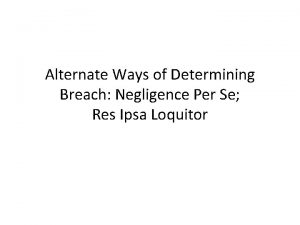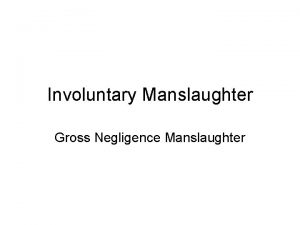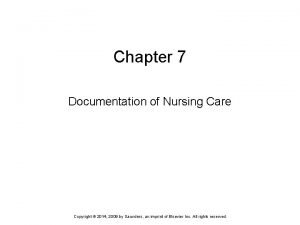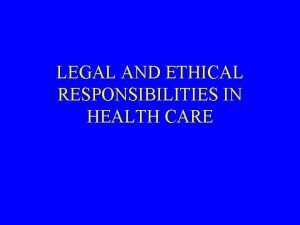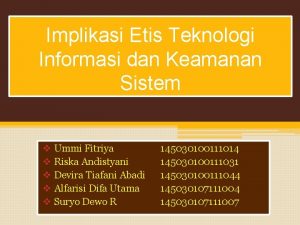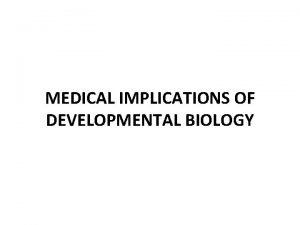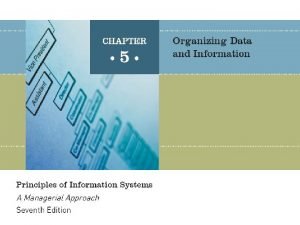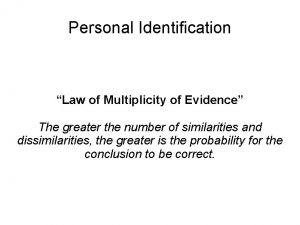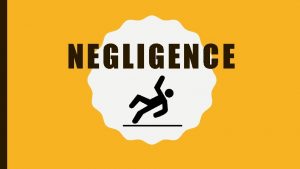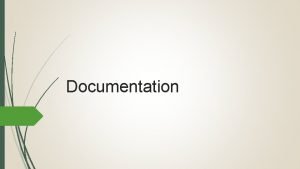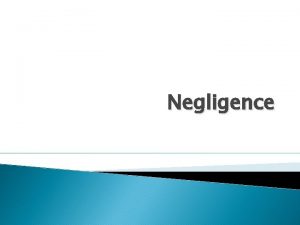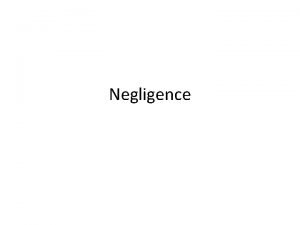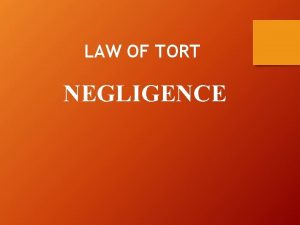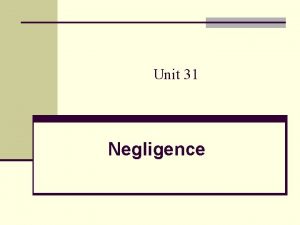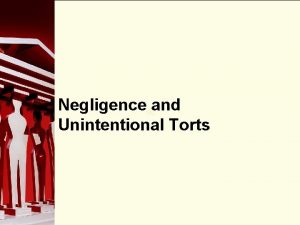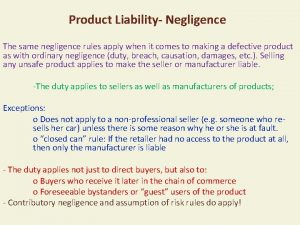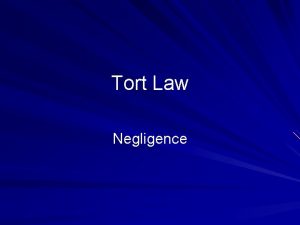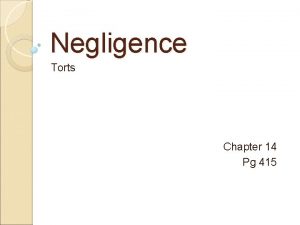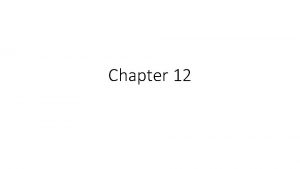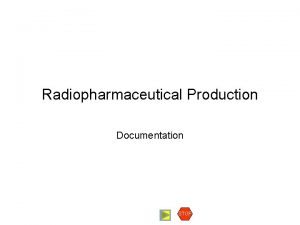LEGAL IMPLICATIONS IN NURSING DOCUMENTATION Legal Terms Negligence




































- Slides: 36

LEGAL IMPLICATIONS IN NURSING. DOCUMENTATION

Legal Terms • Negligence ▫ A general term that refers to conduct that does not show due care ▫ Occurs when someone fails to do something that a reasonably prudent person would do in a similar situation ▫ Four essential characteristics Duty Breach of duty Harm Causation

Legal Terms • Duty ▫ Duty of a professional toward an individual ▫ That duty is established when the nurse patient relationship is started • Breach of duty ▫ Nursing care fell below acceptable standards or the nurse was negligent

Legal Terms • Harm ▫ The patient has been injured in some way • Causation ▫ The breach of duty caused the harm

Legal Terms • Malpractice ▫ Specific type of negligence ▫ Applied to professionals who fail to follow a standard of care prevalent for the profession and thereby harms another person ▫ Ranges from being negligent when caring for a patient to betraying a confidence


Legal Terms • Standard of Care ▫ Level of care a reasonably prudent nurse would have maintained Standards of care change with each new medical advance Must keep up with the latest information in your field Must read journals, attend conferences Be familiar with the policy and procedure manuals and clinical pathways in your facility

Legal Terms • Liability ▫ And obligation or debt that can be enforced by law ▫ In cases of malpractice a person found guilty of a tort is considered legally liable, or legally responsible for the outcome

Liability • Common sources of liability ▫ Most malpractice claims come from routine functions Falls Medication errors Burns Failure to observe Failure to notify MD MDs failure to respond Violation of policies and procedures Defective equipment Improper pt teaching

Liability • Falls ▫ Identify pt who is at risk for a fall and take action Blind Elderly Sedated Dizzy Confused Immediately post-op

Liability • Document use of ▫ Restraints ▫ Side rails ▫ Monitoring of pt • Use care with restraints ▫ Side rails are considered a restraint ▫ May be chemical or physical ▫ Should use the least restrictive method ▫ Continually monitor the pt ▫ Careful documentation


Liability • Medication errors ▫ Perhaps 98, 000 Americans dies each year from med errors ▫ Remember the five rights Right patient, drug, dose, time, route Check the med label three times before administering the med Know the correct dose Know the correct route Know the potential side effects Clarify any order with the physician who ordered the drug


Liability • Burns ▫ Hot water ▫ Heating pads ▫ Heating lamps ▫ Sits bath

Liability • Failure to observe ▫ Keep monitors on the pt ▫ Monitor vital signs after administration of pain meds ▫ Monitor pt closely and report any complications

Liability • Failure to notify the physician ▫ Must communicate any pertinent information to the pt’s MD in a timely manner ▫ Must speak with MD, not leave messages ▫ Should go up the chain of command if unable to get MD ▫ Notify MD if there is a change in the pt’s condition

Liability • Physician's failure to respond ▫ If you feel that the MD does not respond in a satisfactory manner, must notify the supervisor, hospital administrator, or medical director

Liability • Violation of policies and procedures ▫ You are responsible for knowing them • Defective equipment ▫ Must select the appropriate equipment for a particular pt or procedure ▫ Maintain that equipment ▫ Use the equipment properly ▫ Report any problems immediately

Liability • Improper patient teaching ▫ Liable for what you teach or fail to teach ▫ Give written instructions to reinforce the verbal instructions ▫ Document teaching in the chart ▫ Must provide it in the patient’s primary language

Incident Reports • Allows hospital administration to identify problems within the hospital system • Alert administration of an event that may end up in a lawsuit • Important to fill out one to identify problematic situations and create a safe environment • Keep statements factual, objective, do not draw conclusions • Do not mention incident report in charting • May or may not be allowed into court

When you are new to the unit: • Review the key points of the information presented to you in orientation. Ask yourself how practices in this organization differ from your previous position. Validate your assumptions about whether previous expectations apply in this setting.

During your first shift on the unit: • Make a point of reviewing two or more medical records. Pay particular attention to nursing documentation and flow sheets. Are the instructions clear? If not, ask a staff member to clarify.

If and when you float: • Make it a priority to familiarize yourself with documentation expectations unique to the unit to which you have floated.

Perioperative Services: Pre- and Intra-Operative Each phase of the surgical process has specific documentation implications: Intra-operative: Pre-operative: • Comprehensive assessment of the patient’s systems • The patient’s understanding of and consent to the procedure to be performed • • “Time Out”” • • Equipment checks • • Confirmation of the identification of the patient and surgical site • • Positioning of the patient • • Identification of anesthesia reactions • • Measures to prevent burns, injuries from pressure, and other injuries • • Sponge count

Documenting Verbal Orders • Sign and initial your notes. • Record the order in the patient’s record as soon as reasonably possible. Note date and time and then the order verbatim. Write the prescriber’s full name and sign your name. If another nurse witnesses (that is actually hears) the order, that nurse should sign as well. • Label the order “T. O. ” for telephone order or “V. O. ” for verbal order or as policy dictates. Avoid the use of “P. O. ” to represent “phone order” since that designation may be confused with PO meaning “per os” or orally.

• Draw lines through any blank spaces. • Encourage the use of fax in lieu of telephone orders to provide a written record. • Comply with prohibitions on verbal orders, such as: • Most organizational policies prohibit verbal or telephone orders for do not resuscitate orders (DNR). • TJC standards prohibit accepting orders via voice mail.

Documenting Pain Assessment • Your entries in the patient’s record must give evidence that you have met the standards for pain management, including evidence of: • Assessment and effective management of pain in every patient. Assess cultural factors that may affect response to pain. • The patient’s involvement in managing his pain – including patient’s self-assessment of intensity of pain and pain goals. • Initial and ongoing reassessment of pain: • Intensity per pain scale, location, character, frequency, pattern, onset and duration, alleviating and aggravating factors, current pain interventions and effectiveness, and acceptable level of pain. • The patient’s pain management goals. • Pain management history, including effects of pain in the patient’s daily life, such as upon eating, walking, and sleeping. • Appropriate assessment for patients who are children or who are unable to communicate verbally. • Pain assessment at least as frequently as other vital signs. • Assessment and monitoring during the post-procedure period.

Documenting Pain Management • • Date, time Patient behavior Vital signs, including pain scale rating Intervention: position and other non-pharmaceutical relief measures Pain scale rating after intervention and reassessment within thirty to sixty minutes, depending on the medication and administration route Education provided to patients and families regarding pain including: mportance of pain management Reporting pain Assessment process


• Risk for pain • Pain management methods, limitations and side effects – if appropriate, including alternative and complementary methods, such as guided imagery, heat, cold, and massage therapy • Patient’s role in process • Discharge planning which identifies and addresses patients’ pain management needs. (for the patient at end-of-life, documentation reflecting sensitivity to comfort, including physical, psycho-social/emotional, and spiritual comfort) • The patient’s response to interventions, and modifications of the plan if needed


Medications • Follow organizational policy scrupulously regarding documentation of medications. • Use only organization-approved symbols and codes on the MAR. • Document patient response to medications. • Document your patient teaching related to medications. • Never document medications as given before you administer them. Charting medications not givenis criminal as well as unprofessional • If for any reason, you use incorrect or unusual technique in administering a medication, document the situation, follow-up assessment, and any necessary intervention.


Nurses’ actions which have led to medication errors include: • Failure to check the medication administration record (MAR) against the order • Use of banned abbreviations • Leading to administration of a wrong drug or dosage • Mistaken interpretation of illegible penmanship • Failure to obtain clarification as needed, and transcription errors • Failure to document a dose, leading to a duplicate dose when another nurse administers a dose (more likely at breaks or mealtimes, when a second nurse may temporarily assume the patient’s care)

 Legal implications of nursing documentation
Legal implications of nursing documentation Legal dimensions of nursing practice
Legal dimensions of nursing practice Legal implications in nursing practice
Legal implications in nursing practice Scbon
Scbon Legal issues in nursing documentation
Legal issues in nursing documentation Legal implications of social media
Legal implications of social media What are legal implications
What are legal implications Negative chronotropic effect of digoxin
Negative chronotropic effect of digoxin Nursing implications
Nursing implications Examples of decongestants
Examples of decongestants Ranexa nursing implications
Ranexa nursing implications Capsofungin
Capsofungin Glargine nursing implications
Glargine nursing implications Nursing implications for synthroid
Nursing implications for synthroid Trampled calmly over the child's body
Trampled calmly over the child's body Elements of negligence
Elements of negligence Negligence past tense
Negligence past tense Tort of negligence
Tort of negligence Contributory negligence
Contributory negligence Defences to negligence
Defences to negligence Negligence per se vs res ipsa loquitur
Negligence per se vs res ipsa loquitur Gross negligence manslaughter actus reus
Gross negligence manslaughter actus reus Conclusion
Conclusion Pie nursing documentation example
Pie nursing documentation example Like terms and unlike terms in polynomials
Like terms and unlike terms in polynomials Combine like terms
Combine like terms Ethical and legal responsibilities of healthcare workers
Ethical and legal responsibilities of healthcare workers Implikasi etis dari teknologi informasi
Implikasi etis dari teknologi informasi Tautological implications in discrete mathematics
Tautological implications in discrete mathematics Introduction of learning
Introduction of learning Medical implications of developmental biology
Medical implications of developmental biology Educational implications examples
Educational implications examples Implications of database approach
Implications of database approach Portrait parle means
Portrait parle means Educational implications of learning curve
Educational implications of learning curve Math
Math Epistemology of existentialism
Epistemology of existentialism
